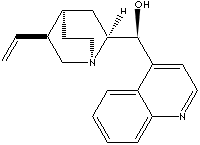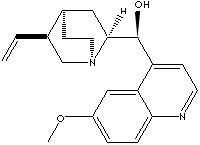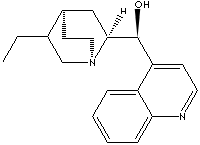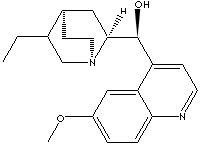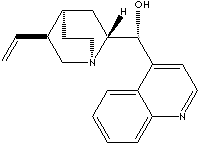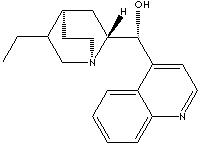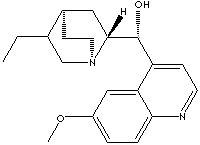| QUININE | ||||||||||||||||||||||
|
PRODUCT IDENTIFICATION |
||||||||||||||||||||||
| CAS NO. |
130-95-0 (Base) 130-89-2 (Hydrochloride) |
|
||||||||||||||||||||
| EINECS NO. |
205-003-2 |
|||||||||||||||||||||
| FORMULA | C20H24N2O2 | |||||||||||||||||||||
| MOL WT. | 324.42 | |||||||||||||||||||||
|
H.S. CODE |
||||||||||||||||||||||
|
TOXICITY |
||||||||||||||||||||||
| SYNONYMS | Legatrin; Novoquinine; Strema; | |||||||||||||||||||||
| 6-Methoxy-alpha-(5-vinyl-2-quinuclidinyl)-4-quinolinemethanol; 6'-Methoxycinchonan-9-ol; Quin-amino; Quinamm; Quindan; Quiphile; | ||||||||||||||||||||||
| SMILES |
|
|||||||||||||||||||||
|
CLASSIFICATION |
|
|||||||||||||||||||||
|
PHYSICAL AND CHEMICAL PROPERTIES |
||||||||||||||||||||||
| PHYSICAL STATE | white to off-white crystalline powder | |||||||||||||||||||||
| MELTING POINT | 173 - 175 C | |||||||||||||||||||||
| BOILING POINT | ||||||||||||||||||||||
| SPECIFIC GRAVITY | ||||||||||||||||||||||
| SOLUBILITY IN WATER | slightly soluble | |||||||||||||||||||||
| pH | ||||||||||||||||||||||
| VAPOR DENSITY |
|
|||||||||||||||||||||
| AUTOIGNITION |
|
|||||||||||||||||||||
| NFPA RATINGS | Health: 2; Flammability: 0; Reactivity: 0 | |||||||||||||||||||||
|
REFRACTIVE INDEX |
||||||||||||||||||||||
| FLASH POINT |
|
|||||||||||||||||||||
| STABILITY |
Stable under ordinary conditions. Light sensitive. |
|||||||||||||||||||||
|
GENERAL DESCRIPTION & APPLICATIONS |
||||||||||||||||||||||
Quinine,
Isolated originally from Cinchona succirubra,
is a white crystalline alkaloid soluble in alcohol, ether, carbon
disulfide, chloroform, and glycerol. It is almost insoluble in water. It is used chiefly (usually in the form of soluble
hydrochloride or sulfate salts) in the treatment of
falciparum malaria resistant to other antimalarials.
Other anti-malaria drugs such as
quinacrine, chloroquine, and primaquine are more effective, but murative
malarial parasite developed resistance to them. Quinine is preferred where
the disease has become highly resistant to other anti-malaria drugs. In addition
to its anti-malarial activity, quinine shows anti-bacteria,
antipyretic, mild oxytocic, local anesthetic, cardiosvascular stimulant, and analgesic
properties, and
it decreases the excitability of the motor endplate. Quinine is used to prevent cardiac
arrythmias and is
used in tonic beverages which are mixed with alcohols for bitter taste. Quinine is one of the
most useful alkaloids for pharmaceutical purposes.
|
||||||||||||||||||||||
| SALES SPECIFICATION (USP, BP) | ||||||||||||||||||||||
|
APPEARANCE |
white to off-white crystalline powder | |||||||||||||||||||||
|
ASSAY |
98.0 % min (on anhydrous basis) |
|||||||||||||||||||||
|
OPTICAL ROTATION |
-163° ~ 170° (C=2% in EtOH) |
|||||||||||||||||||||
| TRANSPORTATION | ||||||||||||||||||||||
| PACKING |
25kgs
in fiber drum
|
|||||||||||||||||||||
| HAZARD CLASS | ||||||||||||||||||||||
| UN NO. | 3335 | |||||||||||||||||||||
| OTHER INFORMATION | ||||||||||||||||||||||
| Hazard Symbols: , Risk Phrases: , Safety Phrases: 22-36 | ||||||||||||||||||||||
| GENERAL DESCRIPTION OF CINCHONA ALKALOIDS | ||||||||||||||||||||||
Cinchona Alkaloids are important subgroup of the polycyclic beta-carboline
alkaloids. They are isolated from cinchona trees. The major eight alkaloids
which occur as four pairs of enantiomers having 2R,3S configuration and 2S,3R
configuration respectively are shown below. They are used in food and beverage
industry as a bitter additive. They are used for pharmaceutical purposes of
antimalarial, antibacteria, local anesthetic, cardiosvascular stimulant, and
analgesic activities. They are useful as chiral elements for asymmetric
synthesis.
|
||||||||||||||||||||||
| PRICES | ||||||||||||||||||||||

